Shiseido: Organisational Behaviour, Motivation, and Team Dynamics
VerifiedAdded on 2023/06/18
|15
|4998
|429
Report
AI Summary
This report provides an analysis of organisational behaviour, focusing on the influence of organisational culture, power, and politics on individual and team behaviour within Shiseido, a Japanese cosmetic company. It evaluates content and process theories of motivation, such as Maslow's hierarchy of needs, Herzberg's two-factor theory, and Vroom's expectancy theory, and their application in achieving organisational goals. The report also examines the characteristics of effective and ineffective teams, highlighting the impact of culture, power, and politics on team and individual performance. Furthermore, it delves into various philosophies and concepts related to organisational behaviour, providing a comprehensive overview of how these elements interact to shape the working environment and overall success of an organisation like Shiseido. Desklib provides access to similar solved assignments and study tools for students.
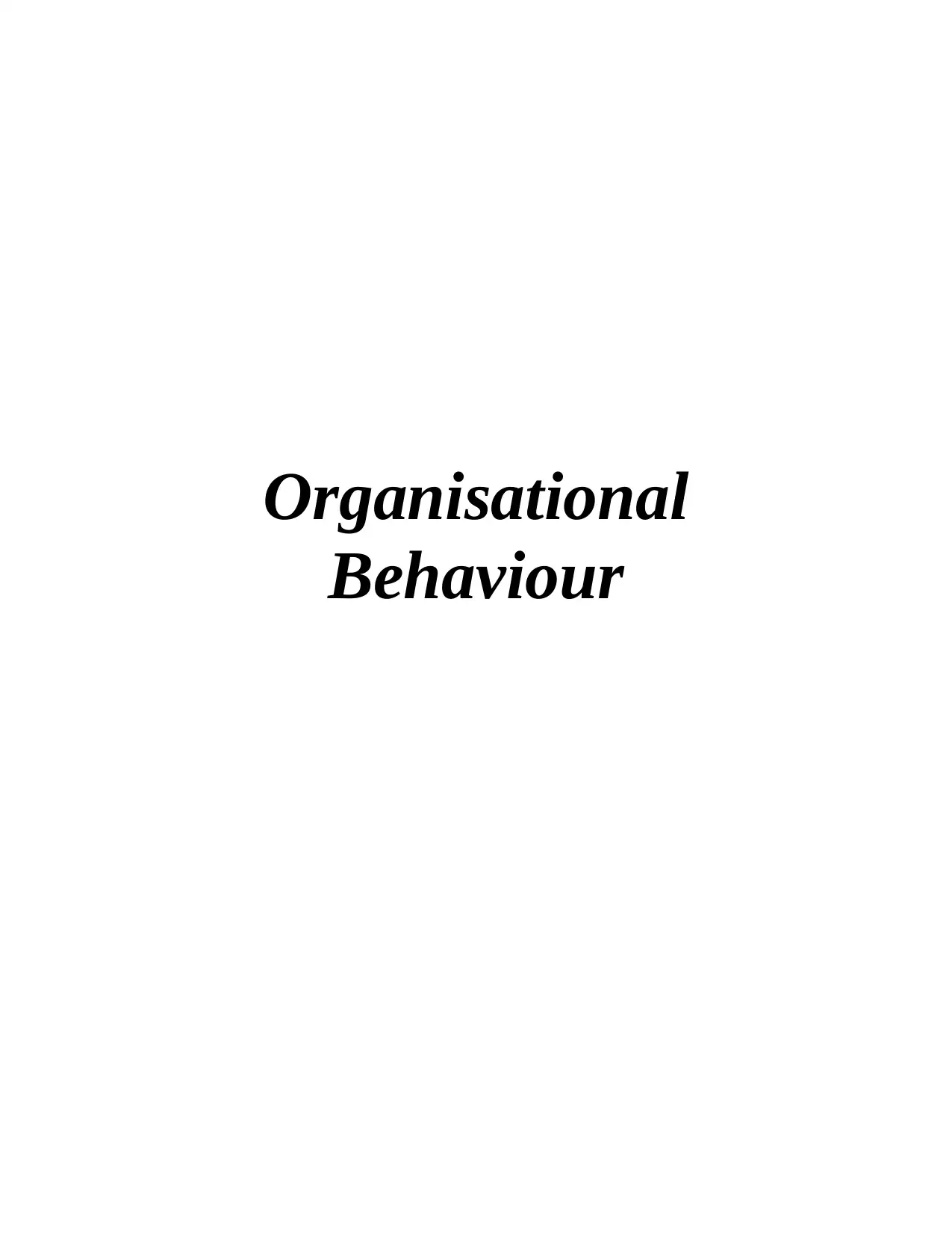
Organisational
Behaviour
Behaviour
Paraphrase This Document
Need a fresh take? Get an instant paraphrase of this document with our AI Paraphraser
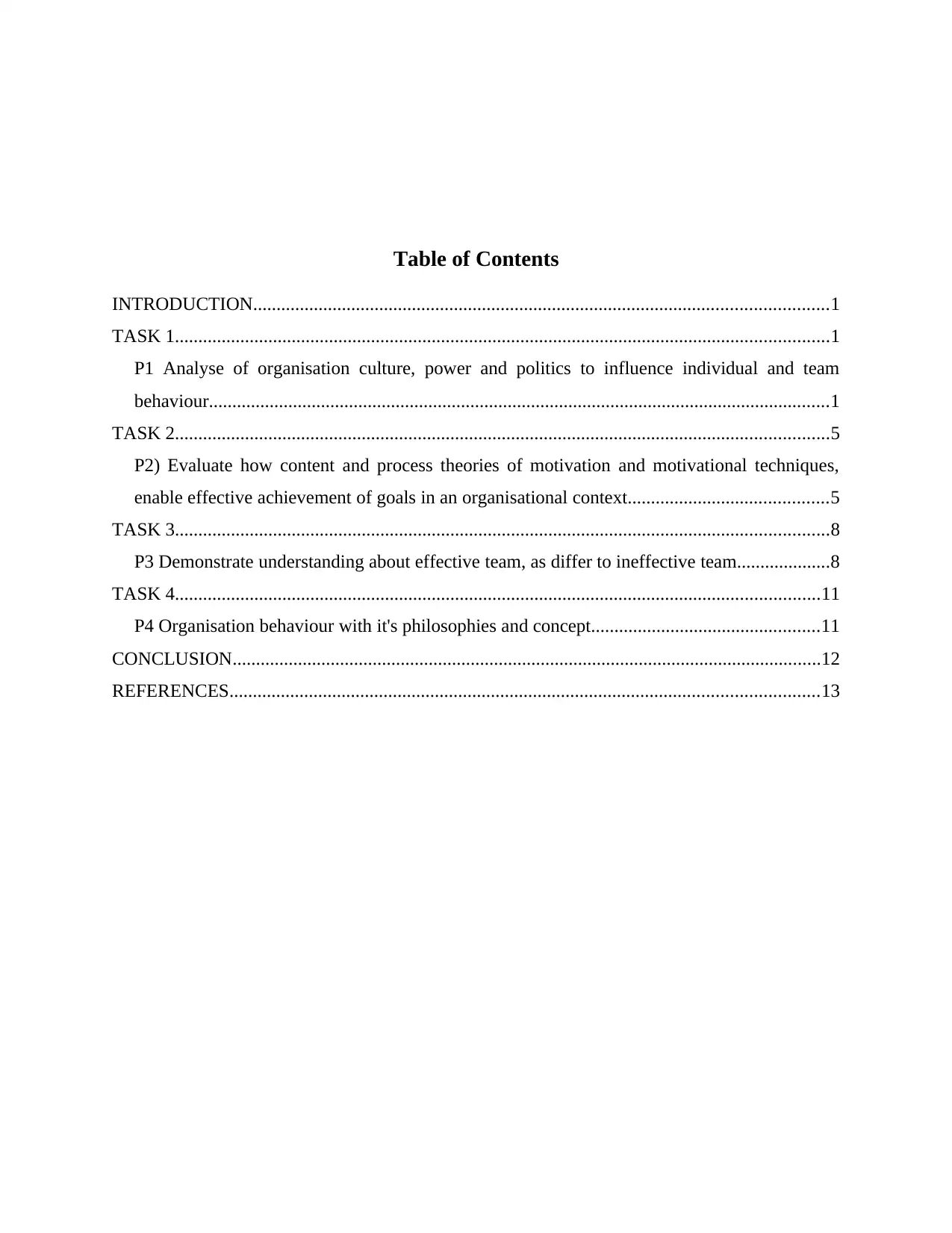
Table of Contents
INTRODUCTION...........................................................................................................................1
TASK 1............................................................................................................................................1
P1 Analyse of organisation culture, power and politics to influence individual and team
behaviour.....................................................................................................................................1
TASK 2............................................................................................................................................5
P2) Evaluate how content and process theories of motivation and motivational techniques,
enable effective achievement of goals in an organisational context...........................................5
TASK 3............................................................................................................................................8
P3 Demonstrate understanding about effective team, as differ to ineffective team....................8
TASK 4..........................................................................................................................................11
P4 Organisation behaviour with it's philosophies and concept.................................................11
CONCLUSION..............................................................................................................................12
REFERENCES..............................................................................................................................13
INTRODUCTION...........................................................................................................................1
TASK 1............................................................................................................................................1
P1 Analyse of organisation culture, power and politics to influence individual and team
behaviour.....................................................................................................................................1
TASK 2............................................................................................................................................5
P2) Evaluate how content and process theories of motivation and motivational techniques,
enable effective achievement of goals in an organisational context...........................................5
TASK 3............................................................................................................................................8
P3 Demonstrate understanding about effective team, as differ to ineffective team....................8
TASK 4..........................................................................................................................................11
P4 Organisation behaviour with it's philosophies and concept.................................................11
CONCLUSION..............................................................................................................................12
REFERENCES..............................................................................................................................13
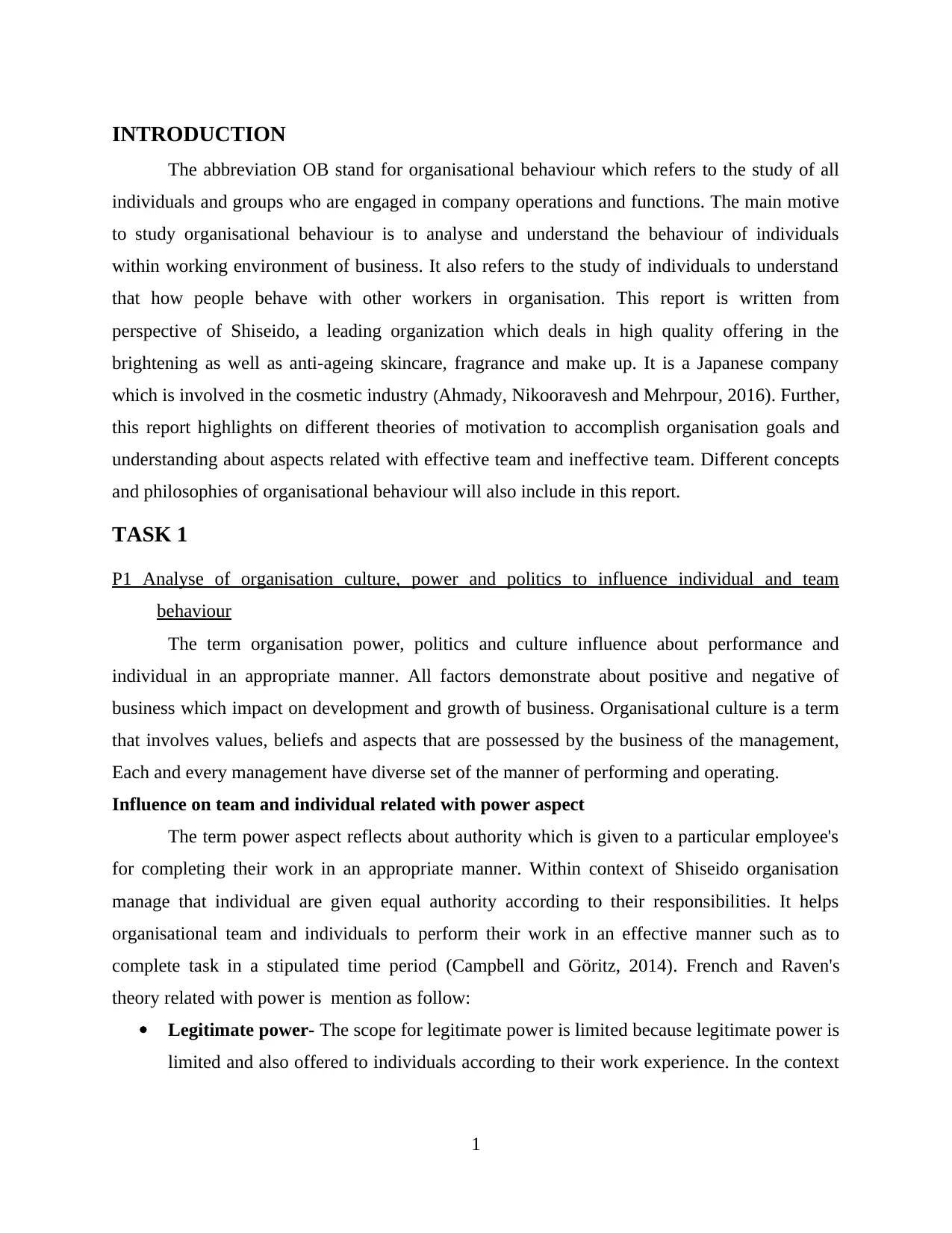
INTRODUCTION
The abbreviation OB stand for organisational behaviour which refers to the study of all
individuals and groups who are engaged in company operations and functions. The main motive
to study organisational behaviour is to analyse and understand the behaviour of individuals
within working environment of business. It also refers to the study of individuals to understand
that how people behave with other workers in organisation. This report is written from
perspective of Shiseido, a leading organization which deals in high quality offering in the
brightening as well as anti-ageing skincare, fragrance and make up. It is a Japanese company
which is involved in the cosmetic industry (Ahmady, Nikooravesh and Mehrpour, 2016). Further,
this report highlights on different theories of motivation to accomplish organisation goals and
understanding about aspects related with effective team and ineffective team. Different concepts
and philosophies of organisational behaviour will also include in this report.
TASK 1
P1 Analyse of organisation culture, power and politics to influence individual and team
behaviour
The term organisation power, politics and culture influence about performance and
individual in an appropriate manner. All factors demonstrate about positive and negative of
business which impact on development and growth of business. Organisational culture is a term
that involves values, beliefs and aspects that are possessed by the business of the management,
Each and every management have diverse set of the manner of performing and operating.
Influence on team and individual related with power aspect
The term power aspect reflects about authority which is given to a particular employee's
for completing their work in an appropriate manner. Within context of Shiseido organisation
manage that individual are given equal authority according to their responsibilities. It helps
organisational team and individuals to perform their work in an effective manner such as to
complete task in a stipulated time period (Campbell and Göritz, 2014). French and Raven's
theory related with power is mention as follow:
Legitimate power- The scope for legitimate power is limited because legitimate power is
limited and also offered to individuals according to their work experience. In the context
1
The abbreviation OB stand for organisational behaviour which refers to the study of all
individuals and groups who are engaged in company operations and functions. The main motive
to study organisational behaviour is to analyse and understand the behaviour of individuals
within working environment of business. It also refers to the study of individuals to understand
that how people behave with other workers in organisation. This report is written from
perspective of Shiseido, a leading organization which deals in high quality offering in the
brightening as well as anti-ageing skincare, fragrance and make up. It is a Japanese company
which is involved in the cosmetic industry (Ahmady, Nikooravesh and Mehrpour, 2016). Further,
this report highlights on different theories of motivation to accomplish organisation goals and
understanding about aspects related with effective team and ineffective team. Different concepts
and philosophies of organisational behaviour will also include in this report.
TASK 1
P1 Analyse of organisation culture, power and politics to influence individual and team
behaviour
The term organisation power, politics and culture influence about performance and
individual in an appropriate manner. All factors demonstrate about positive and negative of
business which impact on development and growth of business. Organisational culture is a term
that involves values, beliefs and aspects that are possessed by the business of the management,
Each and every management have diverse set of the manner of performing and operating.
Influence on team and individual related with power aspect
The term power aspect reflects about authority which is given to a particular employee's
for completing their work in an appropriate manner. Within context of Shiseido organisation
manage that individual are given equal authority according to their responsibilities. It helps
organisational team and individuals to perform their work in an effective manner such as to
complete task in a stipulated time period (Campbell and Göritz, 2014). French and Raven's
theory related with power is mention as follow:
Legitimate power- The scope for legitimate power is limited because legitimate power is
limited and also offered to individuals according to their work experience. In the context
1
⊘ This is a preview!⊘
Do you want full access?
Subscribe today to unlock all pages.

Trusted by 1+ million students worldwide
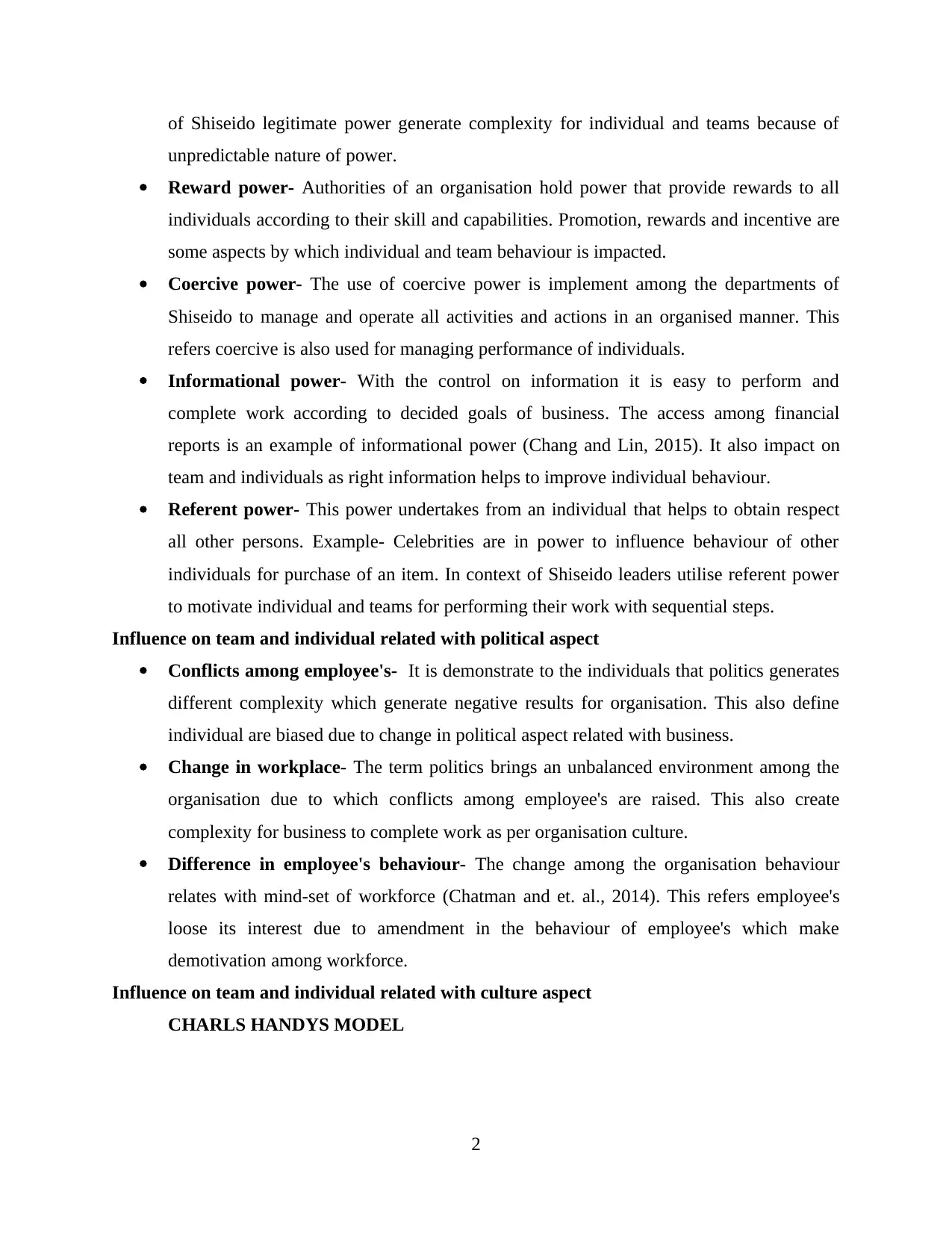
of Shiseido legitimate power generate complexity for individual and teams because of
unpredictable nature of power.
Reward power- Authorities of an organisation hold power that provide rewards to all
individuals according to their skill and capabilities. Promotion, rewards and incentive are
some aspects by which individual and team behaviour is impacted.
Coercive power- The use of coercive power is implement among the departments of
Shiseido to manage and operate all activities and actions in an organised manner. This
refers coercive is also used for managing performance of individuals.
Informational power- With the control on information it is easy to perform and
complete work according to decided goals of business. The access among financial
reports is an example of informational power (Chang and Lin, 2015). It also impact on
team and individuals as right information helps to improve individual behaviour.
Referent power- This power undertakes from an individual that helps to obtain respect
all other persons. Example- Celebrities are in power to influence behaviour of other
individuals for purchase of an item. In context of Shiseido leaders utilise referent power
to motivate individual and teams for performing their work with sequential steps.
Influence on team and individual related with political aspect
Conflicts among employee's- It is demonstrate to the individuals that politics generates
different complexity which generate negative results for organisation. This also define
individual are biased due to change in political aspect related with business.
Change in workplace- The term politics brings an unbalanced environment among the
organisation due to which conflicts among employee's are raised. This also create
complexity for business to complete work as per organisation culture.
Difference in employee's behaviour- The change among the organisation behaviour
relates with mind-set of workforce (Chatman and et. al., 2014). This refers employee's
loose its interest due to amendment in the behaviour of employee's which make
demotivation among workforce.
Influence on team and individual related with culture aspect
CHARLS HANDYS MODEL
2
unpredictable nature of power.
Reward power- Authorities of an organisation hold power that provide rewards to all
individuals according to their skill and capabilities. Promotion, rewards and incentive are
some aspects by which individual and team behaviour is impacted.
Coercive power- The use of coercive power is implement among the departments of
Shiseido to manage and operate all activities and actions in an organised manner. This
refers coercive is also used for managing performance of individuals.
Informational power- With the control on information it is easy to perform and
complete work according to decided goals of business. The access among financial
reports is an example of informational power (Chang and Lin, 2015). It also impact on
team and individuals as right information helps to improve individual behaviour.
Referent power- This power undertakes from an individual that helps to obtain respect
all other persons. Example- Celebrities are in power to influence behaviour of other
individuals for purchase of an item. In context of Shiseido leaders utilise referent power
to motivate individual and teams for performing their work with sequential steps.
Influence on team and individual related with political aspect
Conflicts among employee's- It is demonstrate to the individuals that politics generates
different complexity which generate negative results for organisation. This also define
individual are biased due to change in political aspect related with business.
Change in workplace- The term politics brings an unbalanced environment among the
organisation due to which conflicts among employee's are raised. This also create
complexity for business to complete work as per organisation culture.
Difference in employee's behaviour- The change among the organisation behaviour
relates with mind-set of workforce (Chatman and et. al., 2014). This refers employee's
loose its interest due to amendment in the behaviour of employee's which make
demotivation among workforce.
Influence on team and individual related with culture aspect
CHARLS HANDYS MODEL
2
Paraphrase This Document
Need a fresh take? Get an instant paraphrase of this document with our AI Paraphraser
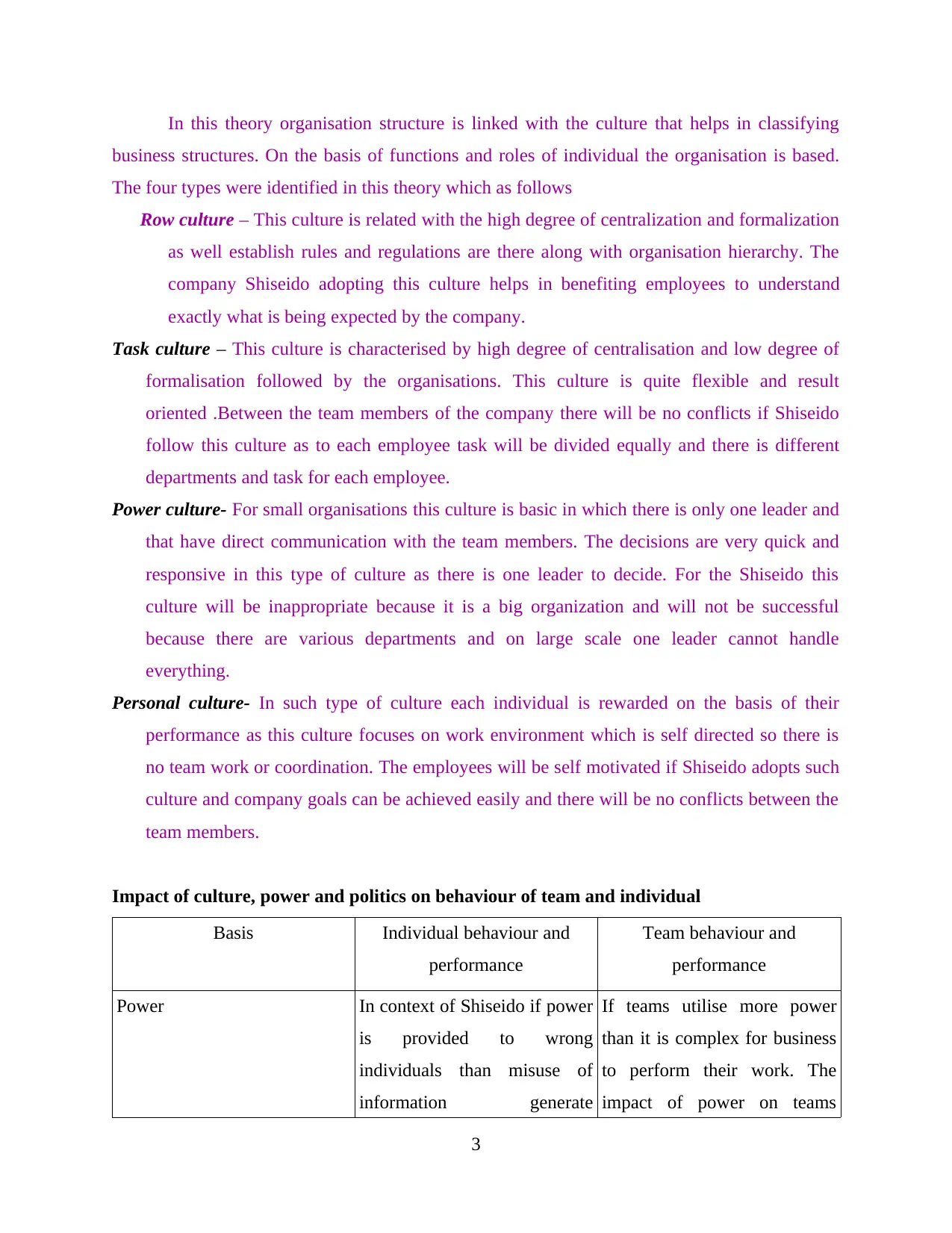
In this theory organisation structure is linked with the culture that helps in classifying
business structures. On the basis of functions and roles of individual the organisation is based.
The four types were identified in this theory which as follows
Row culture – This culture is related with the high degree of centralization and formalization
as well establish rules and regulations are there along with organisation hierarchy. The
company Shiseido adopting this culture helps in benefiting employees to understand
exactly what is being expected by the company.
Task culture – This culture is characterised by high degree of centralisation and low degree of
formalisation followed by the organisations. This culture is quite flexible and result
oriented .Between the team members of the company there will be no conflicts if Shiseido
follow this culture as to each employee task will be divided equally and there is different
departments and task for each employee.
Power culture- For small organisations this culture is basic in which there is only one leader and
that have direct communication with the team members. The decisions are very quick and
responsive in this type of culture as there is one leader to decide. For the Shiseido this
culture will be inappropriate because it is a big organization and will not be successful
because there are various departments and on large scale one leader cannot handle
everything.
Personal culture- In such type of culture each individual is rewarded on the basis of their
performance as this culture focuses on work environment which is self directed so there is
no team work or coordination. The employees will be self motivated if Shiseido adopts such
culture and company goals can be achieved easily and there will be no conflicts between the
team members.
Impact of culture, power and politics on behaviour of team and individual
Basis Individual behaviour and
performance
Team behaviour and
performance
Power In context of Shiseido if power
is provided to wrong
individuals than misuse of
information generate
If teams utilise more power
than it is complex for business
to perform their work. The
impact of power on teams
3
business structures. On the basis of functions and roles of individual the organisation is based.
The four types were identified in this theory which as follows
Row culture – This culture is related with the high degree of centralization and formalization
as well establish rules and regulations are there along with organisation hierarchy. The
company Shiseido adopting this culture helps in benefiting employees to understand
exactly what is being expected by the company.
Task culture – This culture is characterised by high degree of centralisation and low degree of
formalisation followed by the organisations. This culture is quite flexible and result
oriented .Between the team members of the company there will be no conflicts if Shiseido
follow this culture as to each employee task will be divided equally and there is different
departments and task for each employee.
Power culture- For small organisations this culture is basic in which there is only one leader and
that have direct communication with the team members. The decisions are very quick and
responsive in this type of culture as there is one leader to decide. For the Shiseido this
culture will be inappropriate because it is a big organization and will not be successful
because there are various departments and on large scale one leader cannot handle
everything.
Personal culture- In such type of culture each individual is rewarded on the basis of their
performance as this culture focuses on work environment which is self directed so there is
no team work or coordination. The employees will be self motivated if Shiseido adopts such
culture and company goals can be achieved easily and there will be no conflicts between the
team members.
Impact of culture, power and politics on behaviour of team and individual
Basis Individual behaviour and
performance
Team behaviour and
performance
Power In context of Shiseido if power
is provided to wrong
individuals than misuse of
information generate
If teams utilise more power
than it is complex for business
to perform their work. The
impact of power on teams
3

complexity for business. As
individual who are more in
power change their attitude
because of more authority in
business.
minimise the interest of
members because each
individual is focus to work as a
team leader.
Culture If there is a change is
implemented among
organisation culture than
individual also require to work
according to company culture.
So attitude of individuals is
directly impacted (Fleming
and Spicer, 2014).
With the change in culture all
team members also improve
their own-style of work. This
refers change in the negative
impact minimise performance
of organisation in the specific
period of time.
Politics With engagement of
individuals in political aspect
performance of organisation is
impacted. It also create
negative outcome such as
individuals not perform work
according to other colleagues.
With the change in team
politics performance of
employee's generate challenges
as employee's attitude is
changed among teams.
From the above discussion, it is sensed that Charles Handy Model is based on the
organisational culture. This model helps to identify different types of culture within the business.
These culture are power, role, person and task culture. All such type of culture has different
nature and have their own implication on the business. It is seen that Shiseido uses tasks culture
in their business which creates flexibility among employees. This is best culture as it delegates
roles and responsibilities as per the skills and knowledge of employees where work can be done
effectively. Although, there is some downside is that, it brings conflicts among employees as all
are interacted with each other.
4
individual who are more in
power change their attitude
because of more authority in
business.
minimise the interest of
members because each
individual is focus to work as a
team leader.
Culture If there is a change is
implemented among
organisation culture than
individual also require to work
according to company culture.
So attitude of individuals is
directly impacted (Fleming
and Spicer, 2014).
With the change in culture all
team members also improve
their own-style of work. This
refers change in the negative
impact minimise performance
of organisation in the specific
period of time.
Politics With engagement of
individuals in political aspect
performance of organisation is
impacted. It also create
negative outcome such as
individuals not perform work
according to other colleagues.
With the change in team
politics performance of
employee's generate challenges
as employee's attitude is
changed among teams.
From the above discussion, it is sensed that Charles Handy Model is based on the
organisational culture. This model helps to identify different types of culture within the business.
These culture are power, role, person and task culture. All such type of culture has different
nature and have their own implication on the business. It is seen that Shiseido uses tasks culture
in their business which creates flexibility among employees. This is best culture as it delegates
roles and responsibilities as per the skills and knowledge of employees where work can be done
effectively. Although, there is some downside is that, it brings conflicts among employees as all
are interacted with each other.
4
⊘ This is a preview!⊘
Do you want full access?
Subscribe today to unlock all pages.

Trusted by 1+ million students worldwide
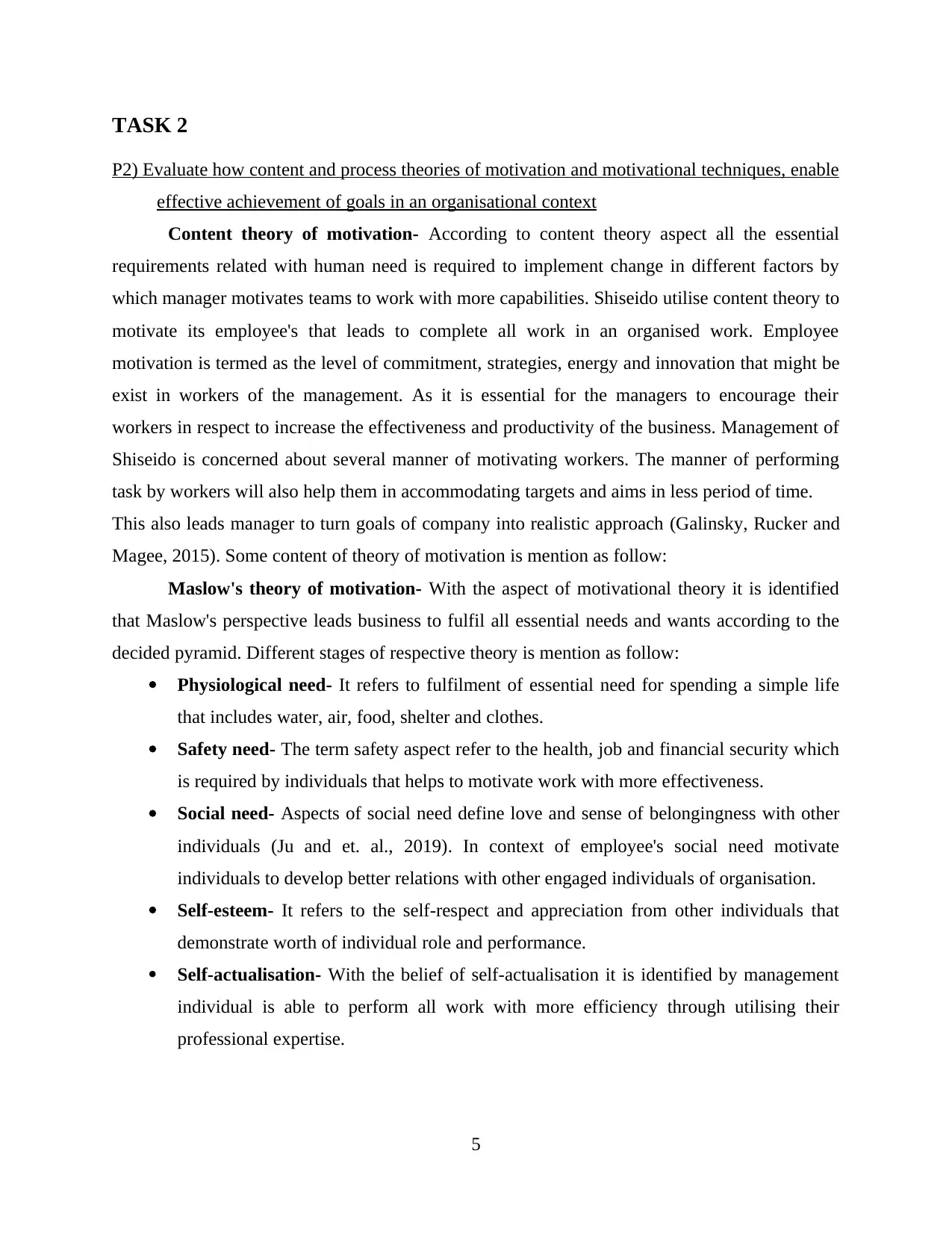
TASK 2
P2) Evaluate how content and process theories of motivation and motivational techniques, enable
effective achievement of goals in an organisational context
Content theory of motivation- According to content theory aspect all the essential
requirements related with human need is required to implement change in different factors by
which manager motivates teams to work with more capabilities. Shiseido utilise content theory to
motivate its employee's that leads to complete all work in an organised work. Employee
motivation is termed as the level of commitment, strategies, energy and innovation that might be
exist in workers of the management. As it is essential for the managers to encourage their
workers in respect to increase the effectiveness and productivity of the business. Management of
Shiseido is concerned about several manner of motivating workers. The manner of performing
task by workers will also help them in accommodating targets and aims in less period of time.
This also leads manager to turn goals of company into realistic approach (Galinsky, Rucker and
Magee, 2015). Some content of theory of motivation is mention as follow:
Maslow's theory of motivation- With the aspect of motivational theory it is identified
that Maslow's perspective leads business to fulfil all essential needs and wants according to the
decided pyramid. Different stages of respective theory is mention as follow:
Physiological need- It refers to fulfilment of essential need for spending a simple life
that includes water, air, food, shelter and clothes.
Safety need- The term safety aspect refer to the health, job and financial security which
is required by individuals that helps to motivate work with more effectiveness.
Social need- Aspects of social need define love and sense of belongingness with other
individuals (Ju and et. al., 2019). In context of employee's social need motivate
individuals to develop better relations with other engaged individuals of organisation.
Self-esteem- It refers to the self-respect and appreciation from other individuals that
demonstrate worth of individual role and performance.
Self-actualisation- With the belief of self-actualisation it is identified by management
individual is able to perform all work with more efficiency through utilising their
professional expertise.
5
P2) Evaluate how content and process theories of motivation and motivational techniques, enable
effective achievement of goals in an organisational context
Content theory of motivation- According to content theory aspect all the essential
requirements related with human need is required to implement change in different factors by
which manager motivates teams to work with more capabilities. Shiseido utilise content theory to
motivate its employee's that leads to complete all work in an organised work. Employee
motivation is termed as the level of commitment, strategies, energy and innovation that might be
exist in workers of the management. As it is essential for the managers to encourage their
workers in respect to increase the effectiveness and productivity of the business. Management of
Shiseido is concerned about several manner of motivating workers. The manner of performing
task by workers will also help them in accommodating targets and aims in less period of time.
This also leads manager to turn goals of company into realistic approach (Galinsky, Rucker and
Magee, 2015). Some content of theory of motivation is mention as follow:
Maslow's theory of motivation- With the aspect of motivational theory it is identified
that Maslow's perspective leads business to fulfil all essential needs and wants according to the
decided pyramid. Different stages of respective theory is mention as follow:
Physiological need- It refers to fulfilment of essential need for spending a simple life
that includes water, air, food, shelter and clothes.
Safety need- The term safety aspect refer to the health, job and financial security which
is required by individuals that helps to motivate work with more effectiveness.
Social need- Aspects of social need define love and sense of belongingness with other
individuals (Ju and et. al., 2019). In context of employee's social need motivate
individuals to develop better relations with other engaged individuals of organisation.
Self-esteem- It refers to the self-respect and appreciation from other individuals that
demonstrate worth of individual role and performance.
Self-actualisation- With the belief of self-actualisation it is identified by management
individual is able to perform all work with more efficiency through utilising their
professional expertise.
5
Paraphrase This Document
Need a fresh take? Get an instant paraphrase of this document with our AI Paraphraser
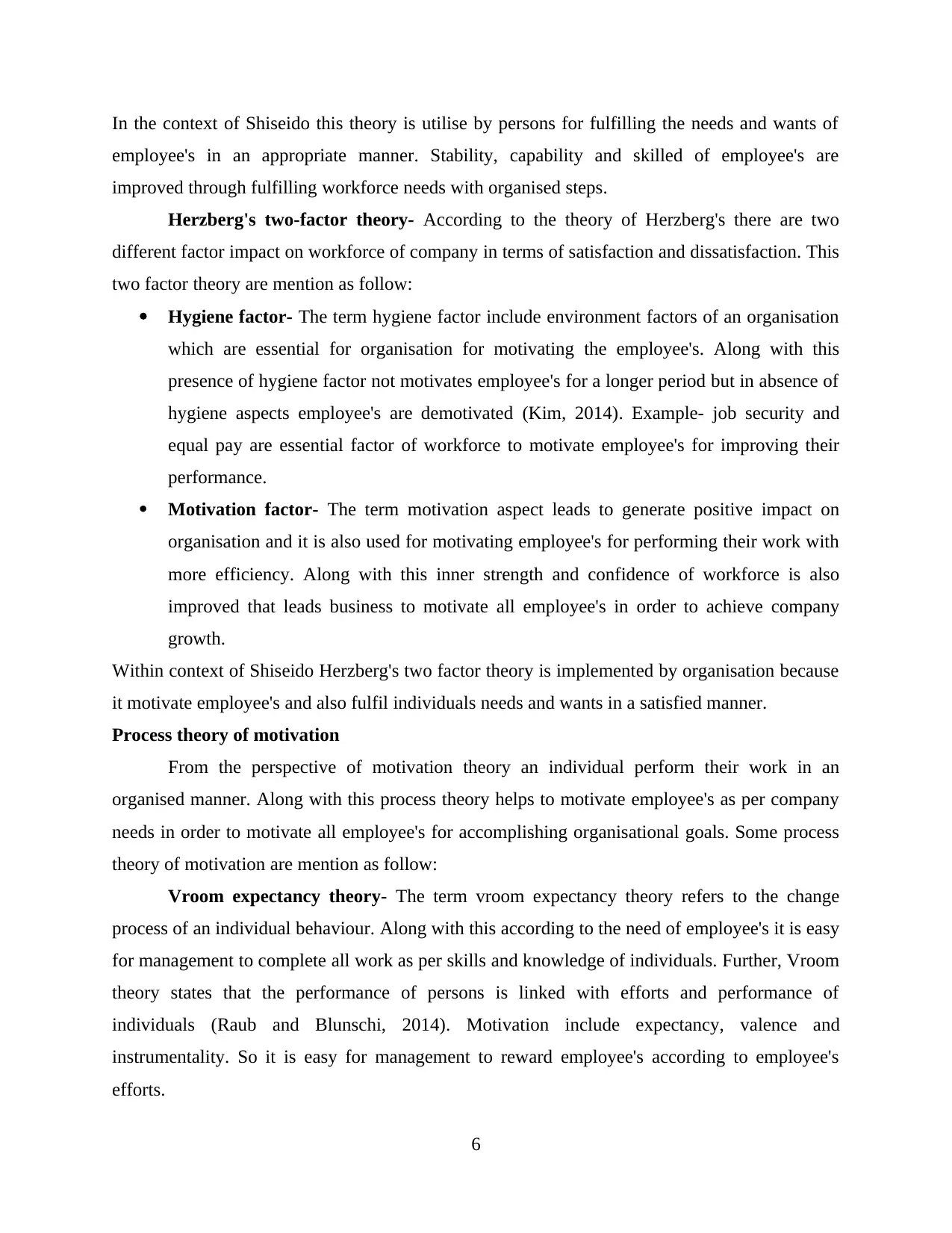
In the context of Shiseido this theory is utilise by persons for fulfilling the needs and wants of
employee's in an appropriate manner. Stability, capability and skilled of employee's are
improved through fulfilling workforce needs with organised steps.
Herzberg's two-factor theory- According to the theory of Herzberg's there are two
different factor impact on workforce of company in terms of satisfaction and dissatisfaction. This
two factor theory are mention as follow:
Hygiene factor- The term hygiene factor include environment factors of an organisation
which are essential for organisation for motivating the employee's. Along with this
presence of hygiene factor not motivates employee's for a longer period but in absence of
hygiene aspects employee's are demotivated (Kim, 2014). Example- job security and
equal pay are essential factor of workforce to motivate employee's for improving their
performance.
Motivation factor- The term motivation aspect leads to generate positive impact on
organisation and it is also used for motivating employee's for performing their work with
more efficiency. Along with this inner strength and confidence of workforce is also
improved that leads business to motivate all employee's in order to achieve company
growth.
Within context of Shiseido Herzberg's two factor theory is implemented by organisation because
it motivate employee's and also fulfil individuals needs and wants in a satisfied manner.
Process theory of motivation
From the perspective of motivation theory an individual perform their work in an
organised manner. Along with this process theory helps to motivate employee's as per company
needs in order to motivate all employee's for accomplishing organisational goals. Some process
theory of motivation are mention as follow:
Vroom expectancy theory- The term vroom expectancy theory refers to the change
process of an individual behaviour. Along with this according to the need of employee's it is easy
for management to complete all work as per skills and knowledge of individuals. Further, Vroom
theory states that the performance of persons is linked with efforts and performance of
individuals (Raub and Blunschi, 2014). Motivation include expectancy, valence and
instrumentality. So it is easy for management to reward employee's according to employee's
efforts.
6
employee's in an appropriate manner. Stability, capability and skilled of employee's are
improved through fulfilling workforce needs with organised steps.
Herzberg's two-factor theory- According to the theory of Herzberg's there are two
different factor impact on workforce of company in terms of satisfaction and dissatisfaction. This
two factor theory are mention as follow:
Hygiene factor- The term hygiene factor include environment factors of an organisation
which are essential for organisation for motivating the employee's. Along with this
presence of hygiene factor not motivates employee's for a longer period but in absence of
hygiene aspects employee's are demotivated (Kim, 2014). Example- job security and
equal pay are essential factor of workforce to motivate employee's for improving their
performance.
Motivation factor- The term motivation aspect leads to generate positive impact on
organisation and it is also used for motivating employee's for performing their work with
more efficiency. Along with this inner strength and confidence of workforce is also
improved that leads business to motivate all employee's in order to achieve company
growth.
Within context of Shiseido Herzberg's two factor theory is implemented by organisation because
it motivate employee's and also fulfil individuals needs and wants in a satisfied manner.
Process theory of motivation
From the perspective of motivation theory an individual perform their work in an
organised manner. Along with this process theory helps to motivate employee's as per company
needs in order to motivate all employee's for accomplishing organisational goals. Some process
theory of motivation are mention as follow:
Vroom expectancy theory- The term vroom expectancy theory refers to the change
process of an individual behaviour. Along with this according to the need of employee's it is easy
for management to complete all work as per skills and knowledge of individuals. Further, Vroom
theory states that the performance of persons is linked with efforts and performance of
individuals (Raub and Blunschi, 2014). Motivation include expectancy, valence and
instrumentality. So it is easy for management to reward employee's according to employee's
efforts.
6
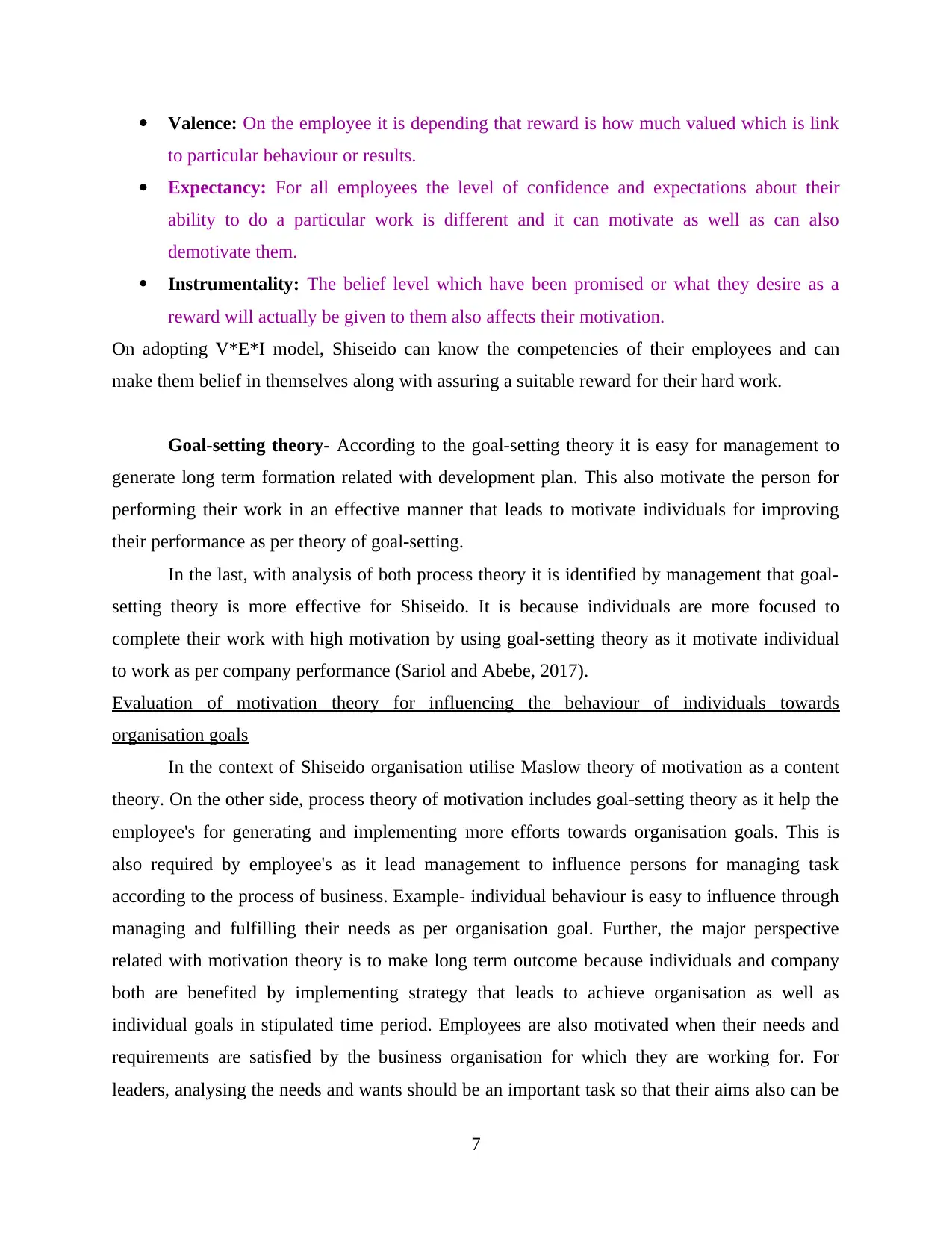
Valence: On the employee it is depending that reward is how much valued which is link
to particular behaviour or results.
Expectancy: For all employees the level of confidence and expectations about their
ability to do a particular work is different and it can motivate as well as can also
demotivate them.
Instrumentality: The belief level which have been promised or what they desire as a
reward will actually be given to them also affects their motivation.
On adopting V*E*I model, Shiseido can know the competencies of their employees and can
make them belief in themselves along with assuring a suitable reward for their hard work.
Goal-setting theory- According to the goal-setting theory it is easy for management to
generate long term formation related with development plan. This also motivate the person for
performing their work in an effective manner that leads to motivate individuals for improving
their performance as per theory of goal-setting.
In the last, with analysis of both process theory it is identified by management that goal-
setting theory is more effective for Shiseido. It is because individuals are more focused to
complete their work with high motivation by using goal-setting theory as it motivate individual
to work as per company performance (Sariol and Abebe, 2017).
Evaluation of motivation theory for influencing the behaviour of individuals towards
organisation goals
In the context of Shiseido organisation utilise Maslow theory of motivation as a content
theory. On the other side, process theory of motivation includes goal-setting theory as it help the
employee's for generating and implementing more efforts towards organisation goals. This is
also required by employee's as it lead management to influence persons for managing task
according to the process of business. Example- individual behaviour is easy to influence through
managing and fulfilling their needs as per organisation goal. Further, the major perspective
related with motivation theory is to make long term outcome because individuals and company
both are benefited by implementing strategy that leads to achieve organisation as well as
individual goals in stipulated time period. Employees are also motivated when their needs and
requirements are satisfied by the business organisation for which they are working for. For
leaders, analysing the needs and wants should be an important task so that their aims also can be
7
to particular behaviour or results.
Expectancy: For all employees the level of confidence and expectations about their
ability to do a particular work is different and it can motivate as well as can also
demotivate them.
Instrumentality: The belief level which have been promised or what they desire as a
reward will actually be given to them also affects their motivation.
On adopting V*E*I model, Shiseido can know the competencies of their employees and can
make them belief in themselves along with assuring a suitable reward for their hard work.
Goal-setting theory- According to the goal-setting theory it is easy for management to
generate long term formation related with development plan. This also motivate the person for
performing their work in an effective manner that leads to motivate individuals for improving
their performance as per theory of goal-setting.
In the last, with analysis of both process theory it is identified by management that goal-
setting theory is more effective for Shiseido. It is because individuals are more focused to
complete their work with high motivation by using goal-setting theory as it motivate individual
to work as per company performance (Sariol and Abebe, 2017).
Evaluation of motivation theory for influencing the behaviour of individuals towards
organisation goals
In the context of Shiseido organisation utilise Maslow theory of motivation as a content
theory. On the other side, process theory of motivation includes goal-setting theory as it help the
employee's for generating and implementing more efforts towards organisation goals. This is
also required by employee's as it lead management to influence persons for managing task
according to the process of business. Example- individual behaviour is easy to influence through
managing and fulfilling their needs as per organisation goal. Further, the major perspective
related with motivation theory is to make long term outcome because individuals and company
both are benefited by implementing strategy that leads to achieve organisation as well as
individual goals in stipulated time period. Employees are also motivated when their needs and
requirements are satisfied by the business organisation for which they are working for. For
leaders, analysing the needs and wants should be an important task so that their aims also can be
7
⊘ This is a preview!⊘
Do you want full access?
Subscribe today to unlock all pages.

Trusted by 1+ million students worldwide
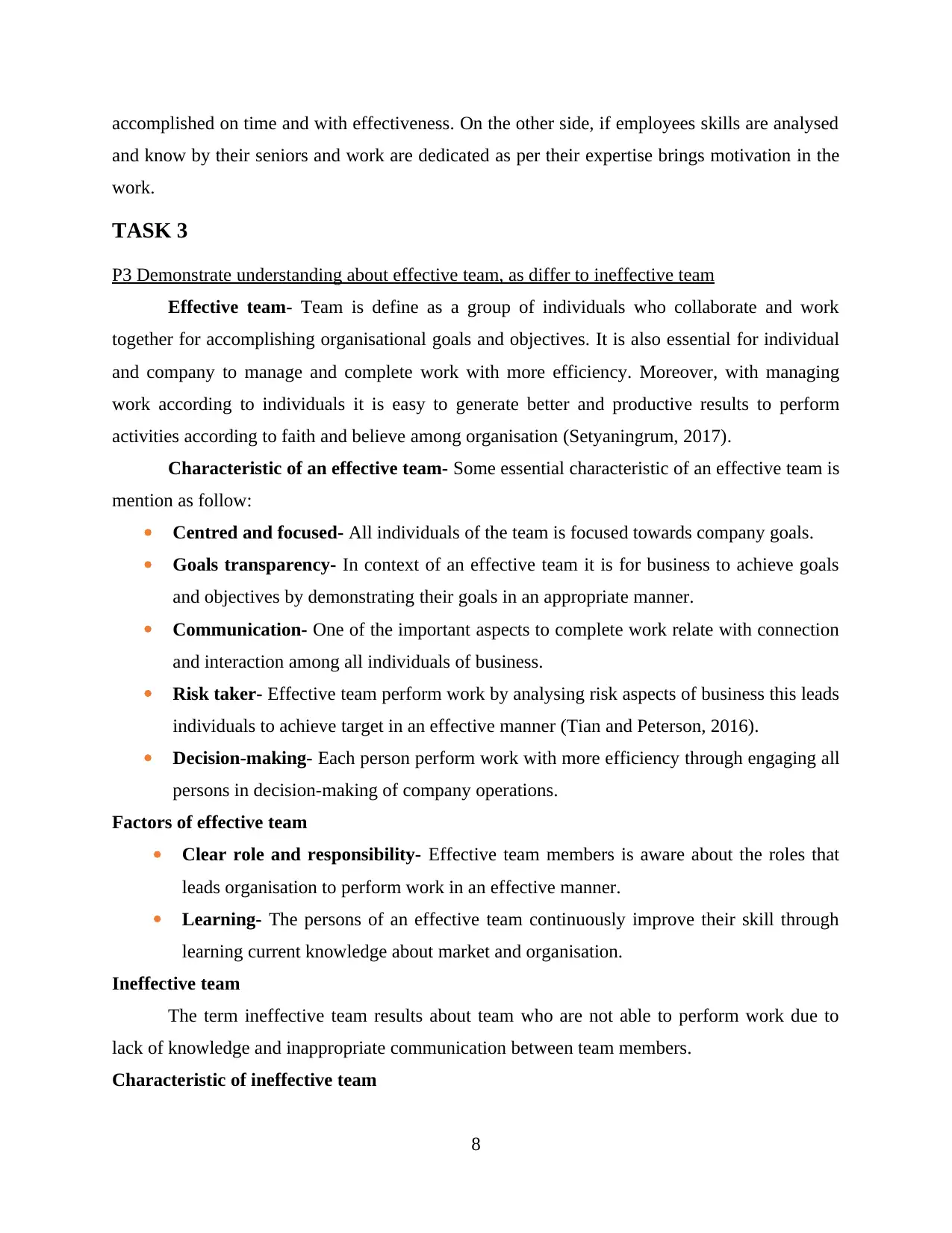
accomplished on time and with effectiveness. On the other side, if employees skills are analysed
and know by their seniors and work are dedicated as per their expertise brings motivation in the
work.
TASK 3
P3 Demonstrate understanding about effective team, as differ to ineffective team
Effective team- Team is define as a group of individuals who collaborate and work
together for accomplishing organisational goals and objectives. It is also essential for individual
and company to manage and complete work with more efficiency. Moreover, with managing
work according to individuals it is easy to generate better and productive results to perform
activities according to faith and believe among organisation (Setyaningrum, 2017).
Characteristic of an effective team- Some essential characteristic of an effective team is
mention as follow:
Centred and focused- All individuals of the team is focused towards company goals.
Goals transparency- In context of an effective team it is for business to achieve goals
and objectives by demonstrating their goals in an appropriate manner.
Communication- One of the important aspects to complete work relate with connection
and interaction among all individuals of business.
Risk taker- Effective team perform work by analysing risk aspects of business this leads
individuals to achieve target in an effective manner (Tian and Peterson, 2016).
Decision-making- Each person perform work with more efficiency through engaging all
persons in decision-making of company operations.
Factors of effective team
Clear role and responsibility- Effective team members is aware about the roles that
leads organisation to perform work in an effective manner.
Learning- The persons of an effective team continuously improve their skill through
learning current knowledge about market and organisation.
Ineffective team
The term ineffective team results about team who are not able to perform work due to
lack of knowledge and inappropriate communication between team members.
Characteristic of ineffective team
8
and know by their seniors and work are dedicated as per their expertise brings motivation in the
work.
TASK 3
P3 Demonstrate understanding about effective team, as differ to ineffective team
Effective team- Team is define as a group of individuals who collaborate and work
together for accomplishing organisational goals and objectives. It is also essential for individual
and company to manage and complete work with more efficiency. Moreover, with managing
work according to individuals it is easy to generate better and productive results to perform
activities according to faith and believe among organisation (Setyaningrum, 2017).
Characteristic of an effective team- Some essential characteristic of an effective team is
mention as follow:
Centred and focused- All individuals of the team is focused towards company goals.
Goals transparency- In context of an effective team it is for business to achieve goals
and objectives by demonstrating their goals in an appropriate manner.
Communication- One of the important aspects to complete work relate with connection
and interaction among all individuals of business.
Risk taker- Effective team perform work by analysing risk aspects of business this leads
individuals to achieve target in an effective manner (Tian and Peterson, 2016).
Decision-making- Each person perform work with more efficiency through engaging all
persons in decision-making of company operations.
Factors of effective team
Clear role and responsibility- Effective team members is aware about the roles that
leads organisation to perform work in an effective manner.
Learning- The persons of an effective team continuously improve their skill through
learning current knowledge about market and organisation.
Ineffective team
The term ineffective team results about team who are not able to perform work due to
lack of knowledge and inappropriate communication between team members.
Characteristic of ineffective team
8
Paraphrase This Document
Need a fresh take? Get an instant paraphrase of this document with our AI Paraphraser
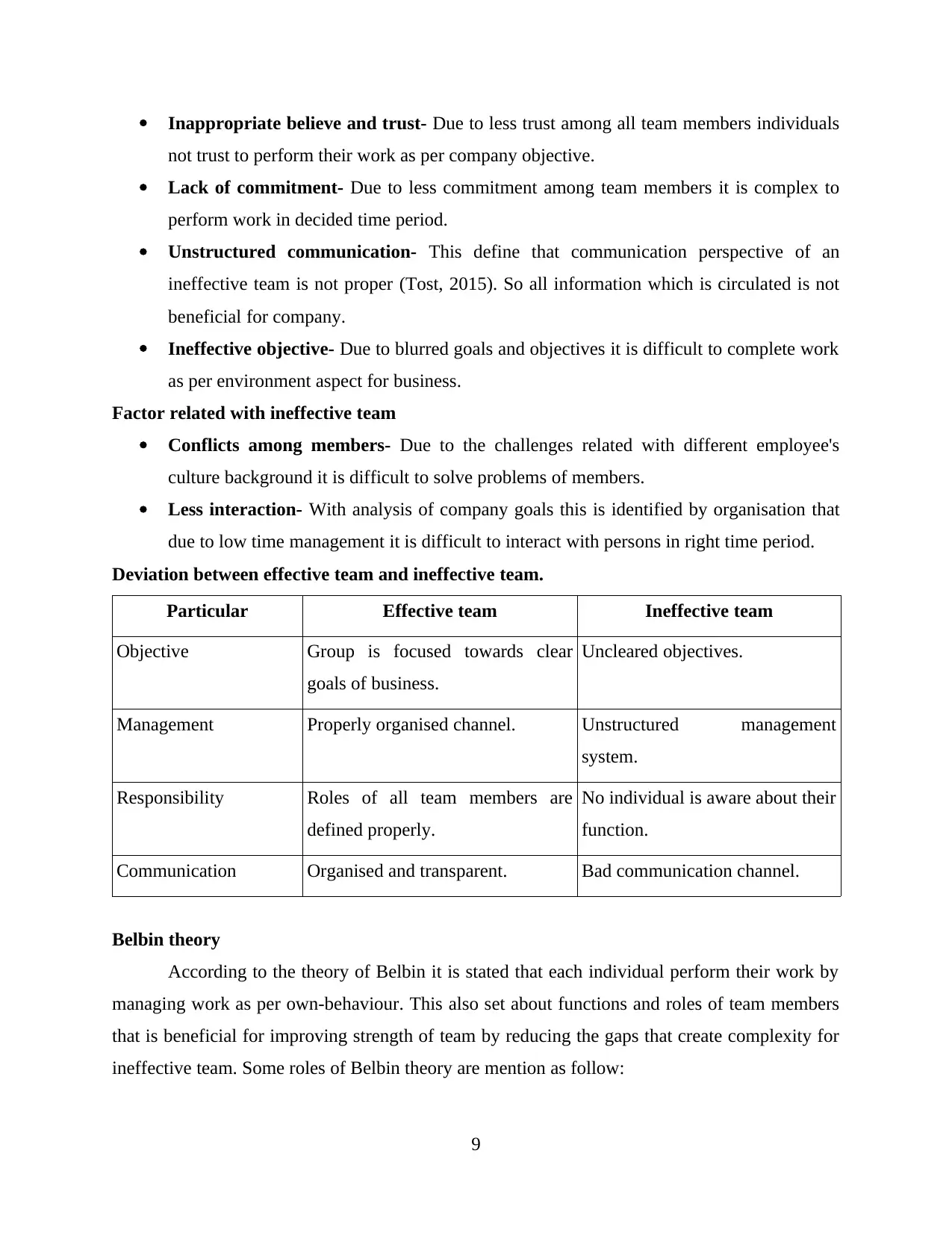
Inappropriate believe and trust- Due to less trust among all team members individuals
not trust to perform their work as per company objective.
Lack of commitment- Due to less commitment among team members it is complex to
perform work in decided time period.
Unstructured communication- This define that communication perspective of an
ineffective team is not proper (Tost, 2015). So all information which is circulated is not
beneficial for company.
Ineffective objective- Due to blurred goals and objectives it is difficult to complete work
as per environment aspect for business.
Factor related with ineffective team
Conflicts among members- Due to the challenges related with different employee's
culture background it is difficult to solve problems of members.
Less interaction- With analysis of company goals this is identified by organisation that
due to low time management it is difficult to interact with persons in right time period.
Deviation between effective team and ineffective team.
Particular Effective team Ineffective team
Objective Group is focused towards clear
goals of business.
Uncleared objectives.
Management Properly organised channel. Unstructured management
system.
Responsibility Roles of all team members are
defined properly.
No individual is aware about their
function.
Communication Organised and transparent. Bad communication channel.
Belbin theory
According to the theory of Belbin it is stated that each individual perform their work by
managing work as per own-behaviour. This also set about functions and roles of team members
that is beneficial for improving strength of team by reducing the gaps that create complexity for
ineffective team. Some roles of Belbin theory are mention as follow:
9
not trust to perform their work as per company objective.
Lack of commitment- Due to less commitment among team members it is complex to
perform work in decided time period.
Unstructured communication- This define that communication perspective of an
ineffective team is not proper (Tost, 2015). So all information which is circulated is not
beneficial for company.
Ineffective objective- Due to blurred goals and objectives it is difficult to complete work
as per environment aspect for business.
Factor related with ineffective team
Conflicts among members- Due to the challenges related with different employee's
culture background it is difficult to solve problems of members.
Less interaction- With analysis of company goals this is identified by organisation that
due to low time management it is difficult to interact with persons in right time period.
Deviation between effective team and ineffective team.
Particular Effective team Ineffective team
Objective Group is focused towards clear
goals of business.
Uncleared objectives.
Management Properly organised channel. Unstructured management
system.
Responsibility Roles of all team members are
defined properly.
No individual is aware about their
function.
Communication Organised and transparent. Bad communication channel.
Belbin theory
According to the theory of Belbin it is stated that each individual perform their work by
managing work as per own-behaviour. This also set about functions and roles of team members
that is beneficial for improving strength of team by reducing the gaps that create complexity for
ineffective team. Some roles of Belbin theory are mention as follow:
9

Team worker- The individuals related with team worker is the one that deal or tackle
with each situation in an appropriate manner. Along with this team worker perform work
in a better situation which leads to accomplish company goals in an effective manner. Int
the last, it also impact on team performance of business.
Coordinator- It is a person that manage and help team member for accomplish of
company goals in a minimum time period (Winterich and Zhang, 2014). Along with this
coordinator are the person which are confidant and they lead organisation to perform
their work with more effectiveness.
Implementer- Individual who perform role of implementer are responsible for
implementing an effective strategy in order to complete all work with more efficiency.
Moreover, implementer convert an idea into a framework to complete task in positive
manner.
Tuckman Theory of team development:
In the year of 1965,this theory was presented by Bruce Truckman. This model is of team
management that termed that teams might have individuals who are expertise in certain field of
area. The theory involves five stages of the team growth that are as follows -
Forming - It is the primary section of team development theory. In this team is given
tasks and actions that have also lead to present in an effective manner. The several course of
actions include at this stage are gathering the data, planning and controlling. Diverse individuals
who have come from diverse background come together and also get time to talk to each other.
Storming - In this section, the formed team start sharing their task and advising their
thoughts to each other with the purpose of completing their task work. As each of them
demonstrate higher term of opportunities between candidates in an effective and efficient
manner.
Norming - In this section, team members works on practices that are agreed on their
standards and ethics in which they might be functioned.
Performing - This level is determined by high level of independence, skills, motivation
and competence in an effective manner.
Adjourning - It is termed as the last section of team development where the task is
completed and members of their team are separate.
10
with each situation in an appropriate manner. Along with this team worker perform work
in a better situation which leads to accomplish company goals in an effective manner. Int
the last, it also impact on team performance of business.
Coordinator- It is a person that manage and help team member for accomplish of
company goals in a minimum time period (Winterich and Zhang, 2014). Along with this
coordinator are the person which are confidant and they lead organisation to perform
their work with more effectiveness.
Implementer- Individual who perform role of implementer are responsible for
implementing an effective strategy in order to complete all work with more efficiency.
Moreover, implementer convert an idea into a framework to complete task in positive
manner.
Tuckman Theory of team development:
In the year of 1965,this theory was presented by Bruce Truckman. This model is of team
management that termed that teams might have individuals who are expertise in certain field of
area. The theory involves five stages of the team growth that are as follows -
Forming - It is the primary section of team development theory. In this team is given
tasks and actions that have also lead to present in an effective manner. The several course of
actions include at this stage are gathering the data, planning and controlling. Diverse individuals
who have come from diverse background come together and also get time to talk to each other.
Storming - In this section, the formed team start sharing their task and advising their
thoughts to each other with the purpose of completing their task work. As each of them
demonstrate higher term of opportunities between candidates in an effective and efficient
manner.
Norming - In this section, team members works on practices that are agreed on their
standards and ethics in which they might be functioned.
Performing - This level is determined by high level of independence, skills, motivation
and competence in an effective manner.
Adjourning - It is termed as the last section of team development where the task is
completed and members of their team are separate.
10
⊘ This is a preview!⊘
Do you want full access?
Subscribe today to unlock all pages.

Trusted by 1+ million students worldwide
1 out of 15
Related Documents
Your All-in-One AI-Powered Toolkit for Academic Success.
+13062052269
info@desklib.com
Available 24*7 on WhatsApp / Email
![[object Object]](/_next/static/media/star-bottom.7253800d.svg)
Unlock your academic potential
Copyright © 2020–2025 A2Z Services. All Rights Reserved. Developed and managed by ZUCOL.





